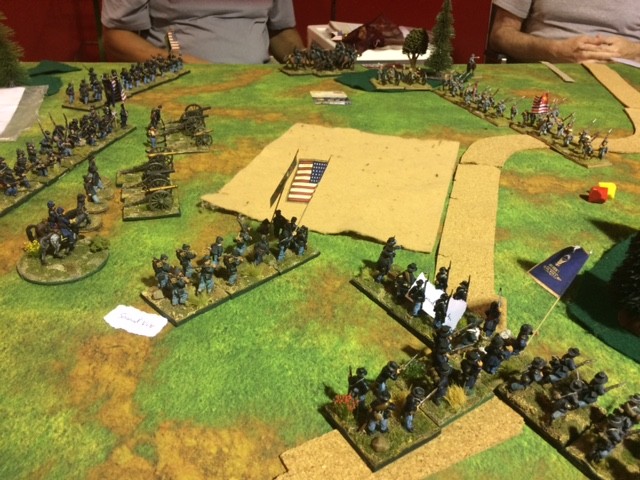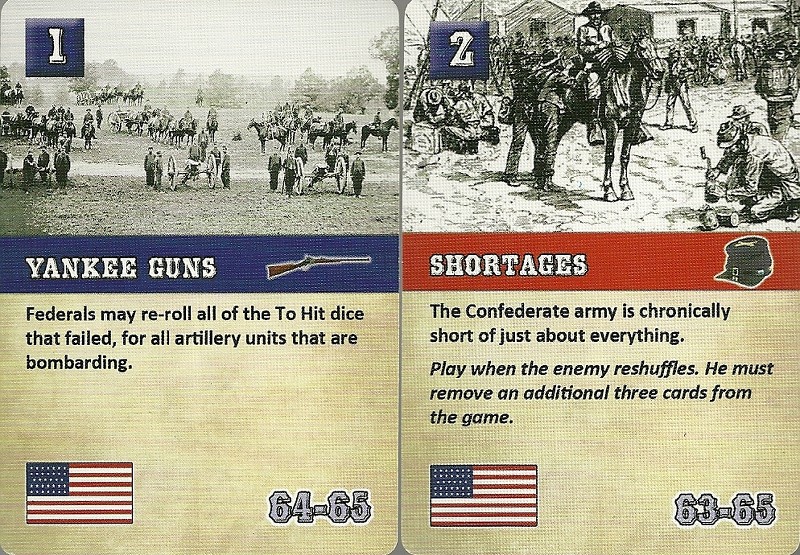A lot of this going on at my games club lately. Would it be better with another set of rules?
I noted with interest this recent interview by Sidney Roundwood, one of the Too Fat Lardies braintrust, with Dave Brown, the designer of the forthcoming Pickett's Charge rules.
PC, as I will hence refer to it, is being published by TFL under their new imprint, Reisswitz Press. As TFL's Richard Clarke explains it, Reisswitz will allow TFL to support the work of other rules writers who share what one might call the Lardies philosophy of ''a large dollop of Clausewitzian friction and an emphasis on command decisions ''.
While I am exited by this news and always happy to support one of Big Rich's projects, I suppose a fair question would be, ''Does the hobby really need another set of ACW rules? Now I am not a tyro in this genre of gaming, but I'm not exactly a grognard either. I started 25 years ago playing Johnny Reb II and found it somewhat maddening. One worked through long lists of modifiers, which gave the impression of realism, but units could charge and strike like summer lightning, in a way that seemed profoundly unrealistic because it didn't seem to reflect any command and control issues or any tactical limitations of the period. I vividly recall having my mouth drop open when I closed in on an enemy formation from its rear, only to see the unit about-face and charge me before I could get a volley off. I suppose one could pivot a tank like that, but not a line of 600 men in the midst of a battle.
Since then I have dabbled in Black Powder and find it somewhat generic. The activation rules are a attempt to model friction, but they seem essentially a random element. Readers of this blog will know that for the past two years, Sam Mustafa's Longstreet has been my ACW drink of choice. I will go to great lengths to defend these rules - they are simple, they force difficult decisions on players at every step of the way, and they capture the narrative arc of the war, so that there is an appreciable difference between a fight in 1861 and one in 1865. In the campaign game we are currently playing at the club, I can assure you that it is more fun to be late war Union than it is to be the early war Union, as the faces of our Reb opponents get grimmer with each battle!
Just two ways in which it is very satisfying to be a late-war Union player in Longstreet
There are other established ACW rules out there which I don't know at all. Fire and Fury is probably the most well known rules set I have never played, which is odd, because Regimental F&F is probably ideally suited to my 28mm collection. I noted with interest the late John Hill's Across A Deadly Field rules, published by Osprey last year, but felt committed to Longstreet and didn't buy it. Beneath these two titles lurks a veritable iceberg of other ACW rules.
Seems familiar. You never forget an elephant.
Briefly, TCHAE shows the influence of TFL's popular WW2 rules, I Ain't Been Shot, Mum (IABSM), in that it uses a system of blinds to bring hidden units into the battle, and uses a card activation system to determine the order in which commanders are activated. Once a commander is activated, he gets a number of commands, or pips, determined by an average dice with some plus or minus mods depending on how skilled or wretched the commander is. Commanders use their pips to achieve tactical effects: moving and changing the formation of units, rallying them, etc. Also, the IABSM influence is seen in the random termination of each turn when the Coffee Card (shades of the Tea Break card) is drawn. Units that have been given pips to reserve their fire can shoot on the Coffee Card.
Not everyone liked TCHAE. One review noted the occasional ambiguities of the rules and some frustration with the TFL philosophy that the rules are as much a toolbox as they are a complete system.
Last week I sent Richard Clarke a message on Twitter, asking him if he could say how TCHAE differed from PC, and he was honest enough to say that it was years since he had played Elephant and didn't remember much about it. I suppose I shouldn't have been surprised by this answer, since rules publishers need to publish new product to stay in business, and hopefully each iteration brings improvements from lessons learned. In terms of TFL's evolution, one hopes that PC is to Elephant what Chain of Command is to IABSM, a natural development of concepts and mechanisms.
What I see in PC from the Roundwood interview is a more nuanced approach to command and control than the pip system. I like the idea that brigade commanders see their degree of control start to degrade as the battle wears down their troops. I also like the idea of the commander sending staff officers to try to keep units on task. I suspect that PC has jettisoned the idea of blinds, which I never felt worked very well for the ACW in the scale (28mm) that I play it in, though perhaps in 6mm.
So, while I am curious to get my mitts on PC, I am going use this Thanksgiving Weekend to put some ACW figures on the table and see how TCHAE plays after five or six years.
In the meantime, blessings to your die rolls!
MP




Shame you never got in on one of Mikey's Fire and Fury games. Not bad, if somewhat abstract.
ReplyDeleteI think you do need another set of rules😁
I like the sound of PC being organised by Brigades but individual regiments and batteries still do stuff
I do remember one of Mikey's figures. I recall that his 15mm figures looked beautiful on the table, but we mostly looked at the figures while he tried to remember the rules. Not much fun.
DeleteTo be honest I always found Fire & Fury "clunky" working out the firing resolutions.
ReplyDeleteThanks Simon. "Clunky" is not a word that inspires confidence in cars, software, or rules.
DeleteI have been buying rules and minis for ACW off and on for 10 years and still not had a single game. Maybe, just maybe PC will be the game that I finally get to the table. Or it will just be fun to read and look good on the shelf.
ReplyDeleteI find that rules sets are like bibles for me. They look good on the shelf, but you only need so many.
DeleteYou owe us pictures of your ACW figures. Do they include ACW zombies? Inquiring minds want to know.
And you shall have them. Koen is tricking me into 28mm SP2 ACW and I actually already have enough 6mm ACW to play SP2. Zombies...well of course there will be zombies!
DeleteHave you tried the new, Glory Hallelujah rules from the Blackpowder stable. I have been extremely impressed by them. So much so that I have returned to ACW after many years away from the period. They contain a lot of detail without being clunky. Give them a try, especially as they are not £35.00, which seems to be the normal price for rules nowadays.
ReplyDeleteStill need the Black Powder rule book though
DeleteStill need the Black Powder rule book though
DeleteThank you Robbie. James makes a good point, I would need the BP Rules ($40ish Canadian) and then the GH supplement, wouldn't I? Sounds like a lot of money and effort. How does GH capture the nature of ACW combat, in your opinion?
DeleteThanks for the overview, for some reasons the ACW has become my favourite period, however I only play skirmish games. I might want to try a mass battle game once, though... TCHAE sounds interesting, PC has not captivated me yet, I have to say. I'd like to try Black Powder. For me, a low figure (and unit) count would be important, so the rules would have to also work well for small battles.
ReplyDeleteAnyway, looking forward to reading about your experiences.
For skirmish games I would suggest sticking with Sharp Practice, none better. Mix that with some of Chris Stoesen's excellent scenarios and you're set for skirmish mayhem.
DeleteBeing curious, I read Sydney's interview with Dave too. PC does sound interesting but I am in a similar position. Do I need another set of ACW rules? While I have followed your Longstreet replays with great interest, I have not tried Longstreet (nor even picked up a copy to peruse). I have read that Across A Deadly Field was a bit under-developed. I cannot say. The guys I game with have settled into the Fire & Fury or Regimental Fire and Fury trench for almost all ACW gaming. The exception being my own rules for large battles. Been a long time since those rules have seen the table too!
ReplyDeleteAnyway, I look forward to seeing TCHAE back out on your gaming table as a refresher and look forward to seeing your review of PC if you strike out in that direction.
Thanks Jon. It is a long weekend here, our Cannuck Thanksgiving, so I am hoping to get that TCHAE game in when not helping Madame Padre w hosting duties and sleeping off turkey.
DeleteLook forward to seeing what you make of the new rules.
ReplyDeleteBeen talking with my ACW gaming pal about our Longstreet campaign and we both came to the conclusion that whilst we are very much enjoying Longstreet especially it's campaign system, RF&F is our current favourite ACW rules set. He picked up Sharp Practice 2 though, so I'll see what it's all about before year's end.
I too love Longstreet and pretty much anything Sam Mustafa publishes! I'm now of fan of cards in my miniature rules to create friction and somewhat random/unexpected events. I love TFL stuff too so do let us know what you think of PC.
ReplyDeleteHere at Reject HQ we use Fire and Fury, they're not perfect in anyone's imagination, but they do play well, they should be renamed Fire and Frustration though. I've never played a game that infuriates me so much. You're only here once, so treat yourself to the new rules.....there's always ebay after all??
ReplyDeleteRay, what about fire & fury do our find so frustrating?
DeleteShame no one's mentioned Altar of Freedom.
ReplyDeleteWell I think I might need new rules. Just tried a game of Glory Hallelujah and enjoyed it. However they haven't grown on me yet.
ReplyDelete